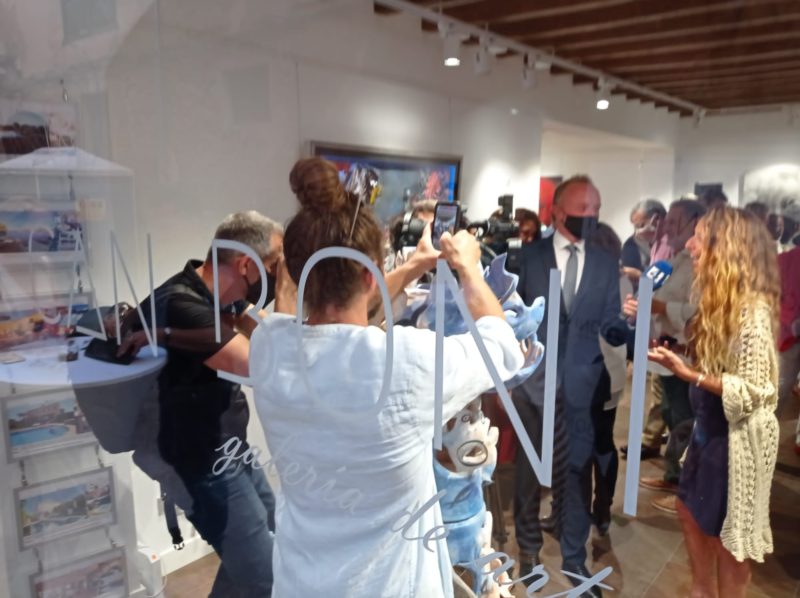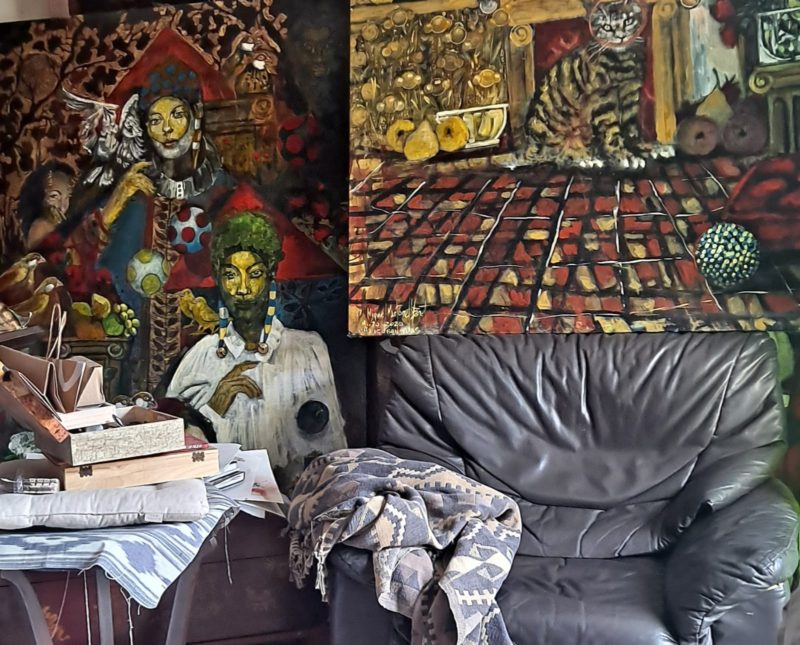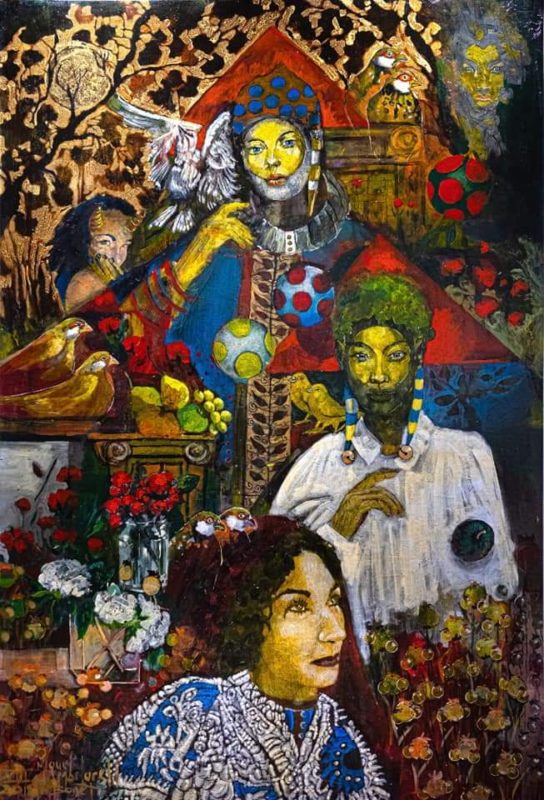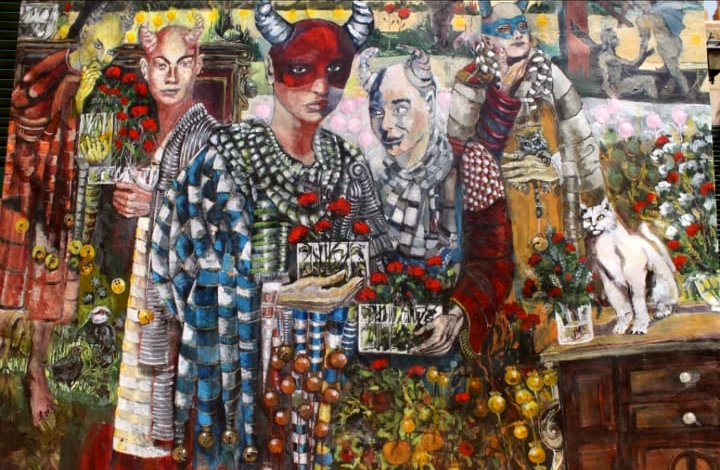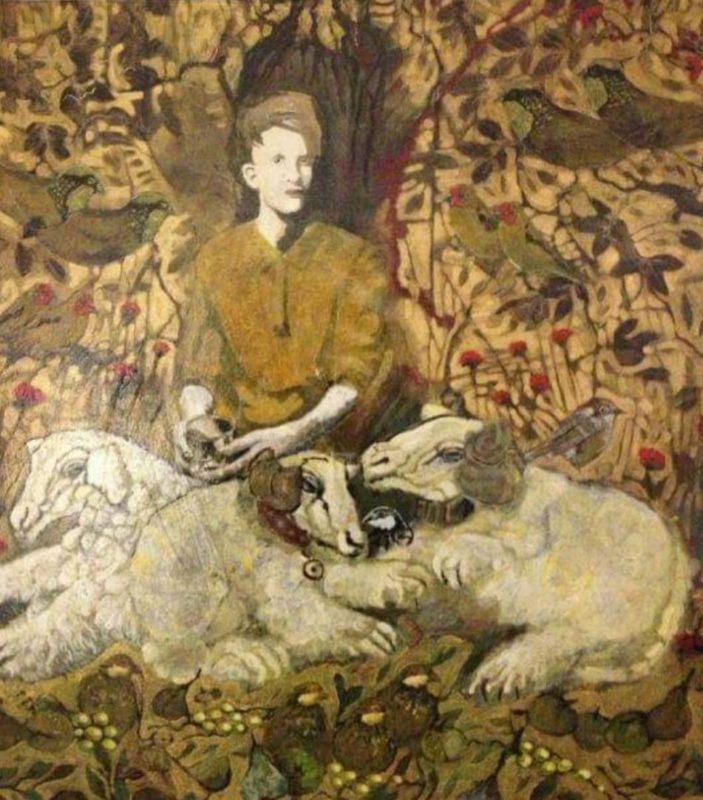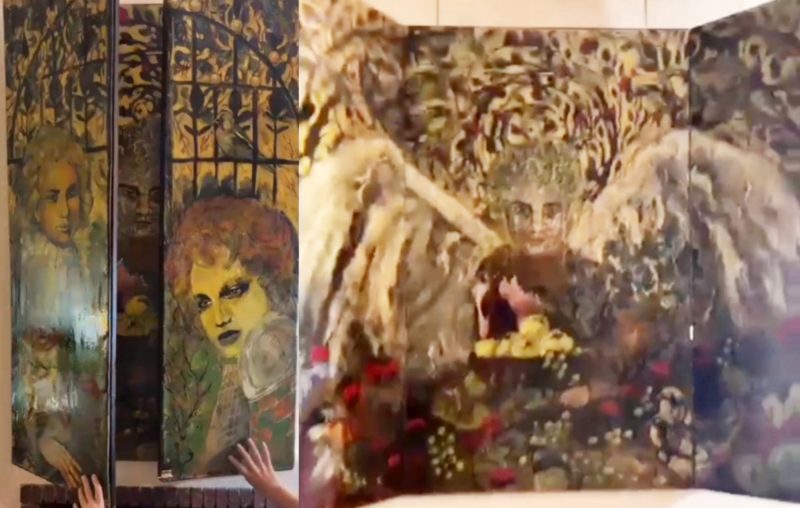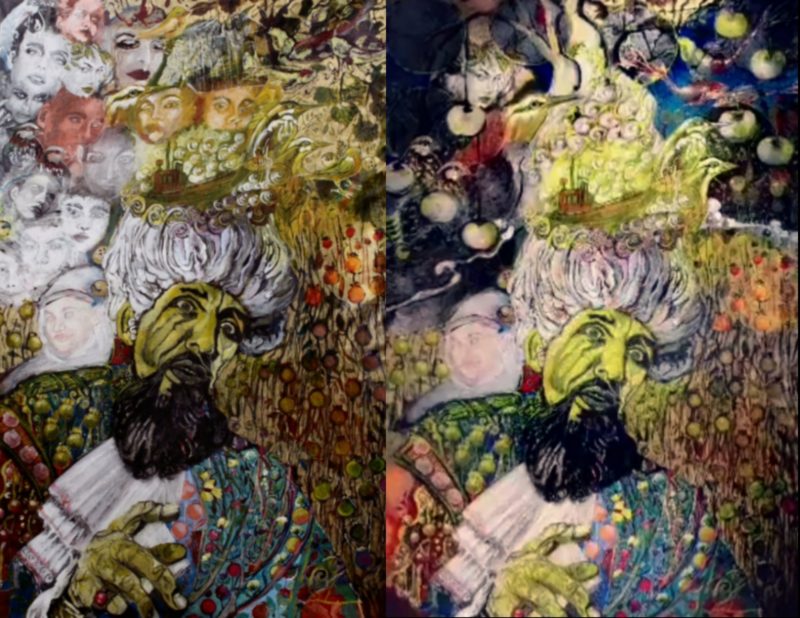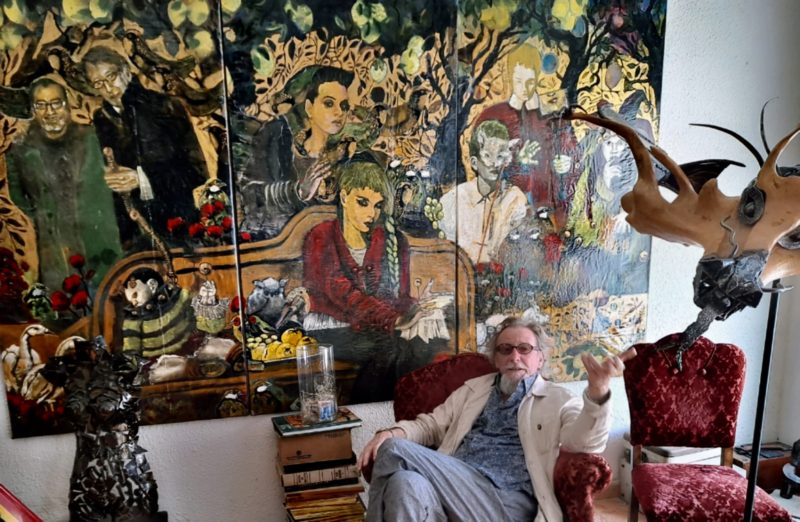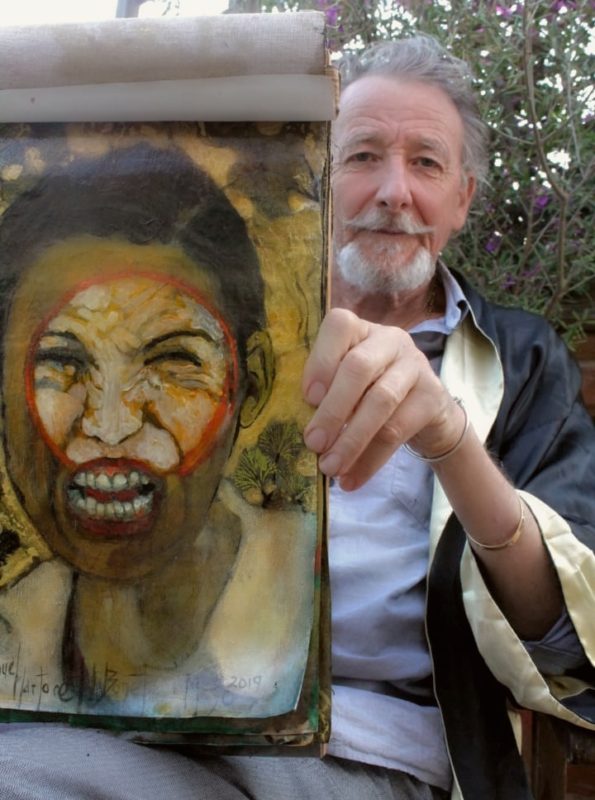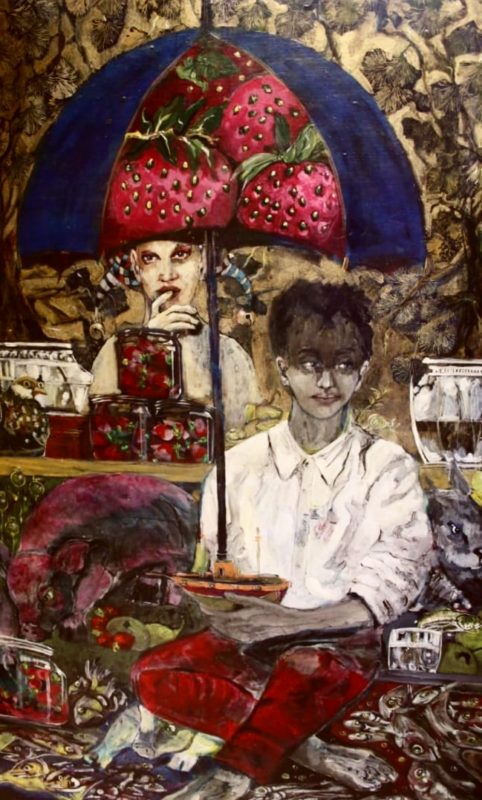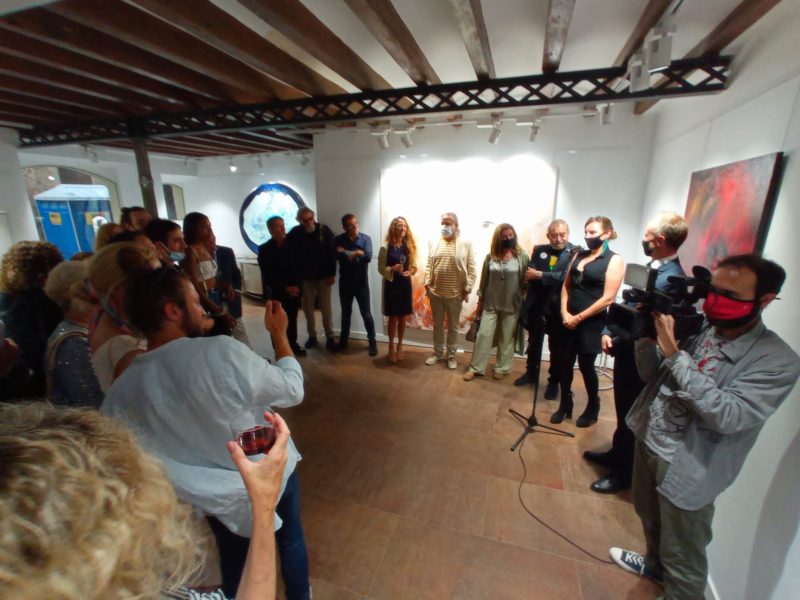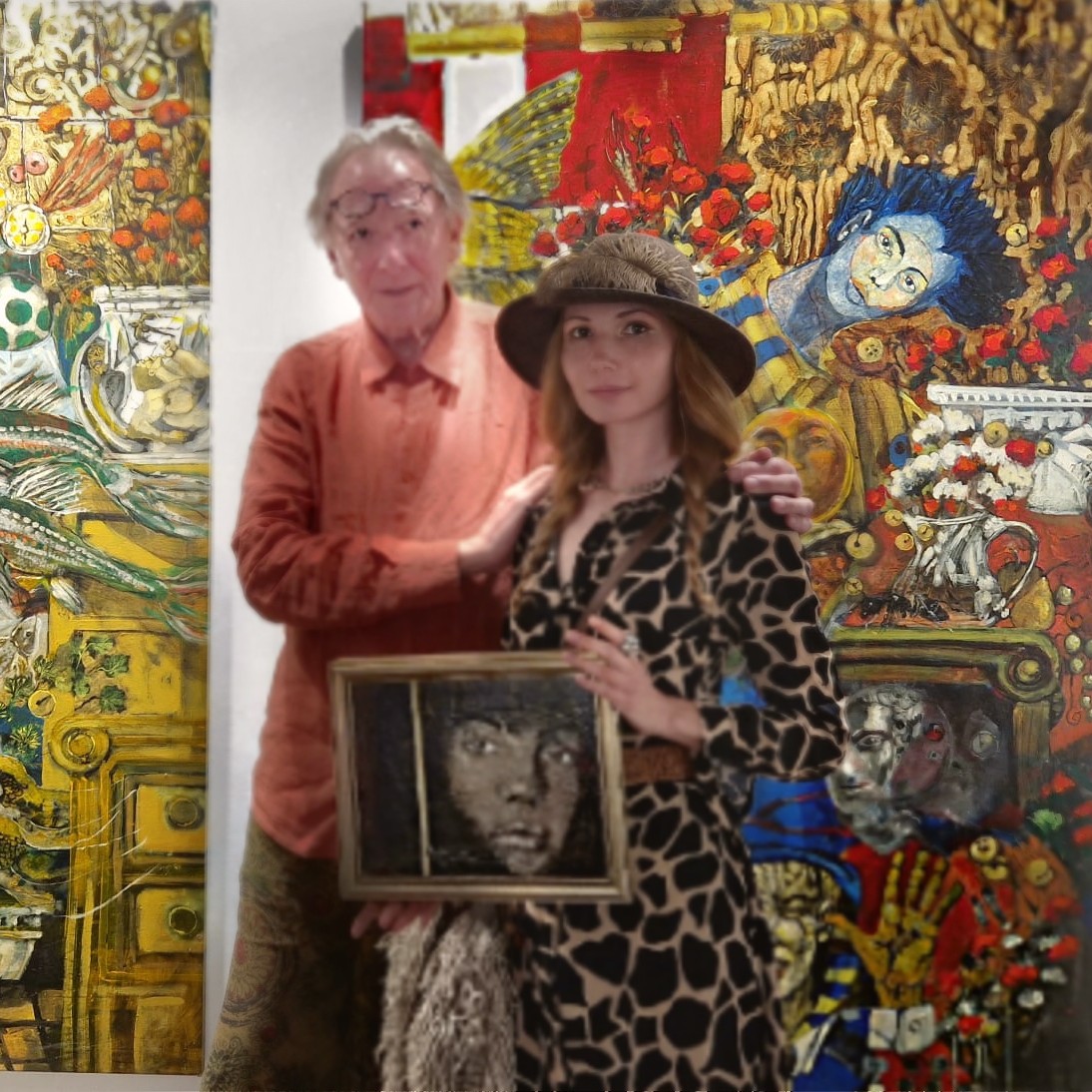
Verita Amare Et had an exclusive visit to the artist Miguel Martorell at the Can Boni Gallery in Palma de Mallorca. They engaged in hours of conversation, from evening till night, discussing the philosophy behind his paintings. Specially for Fine Art Shippers, she wrote an article about her time with the artist and the insights that emerged from this encounter.
Verita Amare Et on the Artist Miguel Martorell: Demon of Art Hunter
“There is no philosophy,” Miguel kept saying, but Verita Amare Et could discern all the intricacies in his paintings and unravel deeper meanings embedded within. This is not solely about stories from the lives of people important to the author; each canvas carries a fragment of the history of the world’s creation during its time. It goes beyond biblical motifs and symbols. In each piece, as you gaze at a particular section of the picture, you find yourself delving into the symbolism of the original universe through Miguel’s vision.
What can be said about a piece of art? At first glance, many tend to judge each work based on the superficial scale of “beautiful” or “ugly.” However, to truly understand art, one must look deeper and appreciate what the artist has unearthed for every attentive viewer to see.
The true vocation of art lies beyond mere embellishment, focusing instead on evoking profound emotions and discoveries, imparting knowledge from the depths where the artist becomes a guide to uncharted waters. Ideally, a person of art should serve as a translator for the viewer, revealing those necessary secrets that aid those who possess the ability to think in their life journeys.
To truly grasp the author’s perspective, one must connect with it on a subconscious level, immersing oneself in the artist’s mind at the precise moment of creating each element. This requires feeling and experiencing the artist’s thoughts during that very instance. At times, the artist might need the viewer’s explanation of the depicted elements, as they might have been in a trance-like state, wholly absorbed in conveying their emotions and visions.
Verita Amare Et: “This is the first picture I’ve seen, and it’s a self-portrait. In this photo, you’ll find only a fragment named “An Angel And The World,” but you can distinctly see the intense gaze of an angel holding a sphere in his hands—a planet or perhaps a representation of the soul with its profound mysteries carefully guarded by the character in the picture. The artist, much like the keeper of a key, encapsulates his thoughts about life, communicating through symbolic fragments and conveying the sensations of the subconscious through their art.”
Just as in life, there is no sole focus on something purely positive or entirely negative. Instead, everything intertwines simultaneously; at first glance, clear boundaries seem to exist. However, the true essence of the message behind each symbol lies in the absence of absolutes: the demons that whisper, “Do it,” and the angels that welcome individuals to paradise all possess their inherent characteristics, neither purely good nor purely bad. There exists a balance, and this equilibrium is exhibited in every single piece of art.
Miguel Martorel started drawing in childhood, beginning with the simplest things. From a young age, he was attentive not only to people and their stories but also has had a special relationship with nature, particularly with the birds he joyfully feeds and the plants in his garden. “Everything grows from the seeds.”
Miguel Martorell’s paintings contain life
Miguel Martorell weaves his personal vision and thoughts about the stories of life, combining numerous details into a single picture, seamlessly bringing together the smallest elements—much from little, just like life itself. The artworks are bound together by a common meaning, as images opposing each other in nature unite to form a cohesive whole. Each story stands complete and self-sufficient, delivering diverse messages in every work, even within a series of paintings created in similar colors. These similar tones are not only designed to admire the deep, juicy, and saturated colors alongside the warmth of the golden heavenly light but also to help the viewer focus on each plot without distractions, considering the richness of the images.
Each element in the artwork supports the overall meaning, originating from a single point and gradually expanding with new signals added over the course of several weeks, prompting viewers to contemplate the deeper significance. The carefully chosen colors serve to accentuate one another, and as a result, the entire picture resonates like a melody. A blend of diverse and often contrasting characters—angels, demons, people, animals, and plants from the author’s garden—interact and strengthen each other. The vibrant and rich hues reflect the abundance of life itself, while the golden background transforms into a pure and warm, almost icon-like light.
Paintings live their lives under the brush of the artist, but he always keeps them under control. It takes just as much time as it takes.
• A painting deserving special attention is “Angels-Guardians. Gate Guardians,” a board resembling an icon with doors that open like gates. Inside, we see an angel surrounded by fruits, symbolizing abundance and hospitality. Beyond the angel lie the gates to the Kingdom of Heaven, along with trees bearing abundant fruits. The trees are shaped like spirals, representing an element of the universe’s creation. This angel warmly and sternly welcomes souls before the gates to paradise. As the two doors of this picture open, revealing two wings, one feels compelled to utter the words: “Open the doors, spread the wings, and open your eyes!”
• Each piece is refined until it fully satisfies the author. For instance, the background of one of the paintings underwent six revisions. It was the picture “Navarro” depicting the actor Navarro, where Miguel Martorell initially portrayed various faces of the audience with different characters. After numerous corrections, only one woman remained in the background among all the spectators. As Miguel himself said, “More than one female spectator is not needed; now everything is perfect.”
• The painting “Guardians of Art” depicts a demon of Art on a leash in the garden. It is not about someone forcing the artist to draw; rather, the author himself pursues the demon of Art, holding everything in his hands, the hands of a man. Miguel is in complete control, urging the demon to accompany him, saying, “Come on, come with me; it’s time to draw!’
• Bright-colored “Portrait of Federica” delves into the theme of real pain and human suffering, as well as inhuman agony. The focal point centers on a red circle, depicting either a scream or a roar, showcasing the raw beauty and intensity of profound and powerful emotions. It presents feelings that people usually wish not to experience for themselves. Nevertheless, this aspect of life, which still exists among humanity, stands as a vestige, evidence of the imperfection of the world. Among all the vivid emotional images present in the world of art, this painting is one of the most striking and authentic, capturing the essence of this intense emotion felt by all beings, regardless of who they are. It’s an emotion universally experienced yet difficult to express elegantly through art for everyone.
• One of the paintings, titled “Creation,” is dedicated to the inception of the world. It portrays the gods in the form of jesters, symbolizing the playful and comical nature of the world’s creation, where contrasts intertwine, and the gods are depicted as mere jokers. In front of them stands a bottle of water, resembling the water of life, which might be mistaken for alcohol at first glance. In reality, the world is sustained by water; it is present in everything and serves as the source of life.
• “The Boy Who Dreamed of the Sea” is a portrait of a boy holding a boat in his hands. In the background, we see a demon who wishes to converse with the boy, but his thoughts are solely consumed by the sea. His head is turned away not only from the demon but also from the ship in his hands. He pays no attention to the berries so close to him. The boy loves the sea wholeheartedly, but he cannot be there for some personal reasons. Everyone can sense the meaning, but only a discerning viewer can perceive the full depth and not just the beautiful combinations of masterfully selected images and shades. All works contain precisely intuitive geometry, and only it can be deemed true. All of this bestows Miguel Mantorell’s series of paintings with a special charm and value.
• A new large-sized painting by Miguel Martorell, titled “Heaven…..Adam, Eve, the devil, a passing lady and Abel in the Background,” will soon be completed. Like his previous works, it will be in his unique, immediately recognizable personal style. One can spend endless hours deciphering this painting, a complex code, and the public will have the chance to do so on September 26, 2023, at the Can Boni Gallery in the heart of ancient Palma de Mallorca, where it will be presented for the first time.
Photo courtesy of Miguel Martorell and Verita Amare Et

